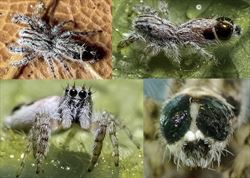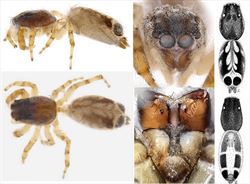
Examples of live Abracadabrella elegans
Illustrator (and ©) R. Whyte

Aspects of the general morphology of Abracadabrella elegans, E. lewiston (RT) and A. birdsville (RB)
Illustrators (and ©) B.J, Richardson (CSIRO) & M. Żabka (diag.) (QMB)

Palp morphology of Abracadabrella sp.(L) and A. elegans (R)
Illustrators (and ©) B.J. Richardson (CSIRO), M. Żabka (diag.) (QMB)

Epigyne morphology of Abracadabrella elegans
Illustrators (and ©) B.J. Richardson (TL) (CSIRO), R. Whyte (BL), M. Żabka (diag.) (QMB)
Abracadabrella Zabka, 1991
Taxonomy
Abracadabrella has three described Australian species: Abracadabrella birdsville, A. elegans and A. lewiston. The genus is part of an Australasian clade (Maddison et al 2008) including Apricia, Clynotis, Holoplatys, Huntiglennia, Ocrisiona, Opisthoncus, Paraphilaeus, Paraplatoides, Pungalina, Tara, Trite and Zebraplatys (Maddison 2015). Further information on the genus and described species can be found in Richardson and Żabka (2017) and Whyte and Anderson (2017).
Description
Abracadabrella spp. are small to medium-sized spiders, ranging in body length from 3 to 7 mm. The cephalothorax is low in profile, highest at the posterior lateral eyes. The head, viewed from above, is pear-shaped, widest behind the posterior lateral eyes. The abdomen is elliptical. There are two black, rounded mounds on the rear of the abdomen appearing to mimic the eyes of a large fly. The chelicerae have a single retromarginal tooth (unident) with two teeth opposite on the promargin. The legs are not particularly elongated or massive, more or less of equal length, the first pair of legs slightly more robust than the others.
The male’s palp has a long, thin, gently-tapering embolus arising at around 6 o’clock and proceeding in a gentle clockwise curve, ending in a slender, curved tip at about 1 o’clock near the upper right face of the cymbium. The tegulum has a somewhat vitreous looking shield over the lower part. The simple, tapered retro-lateral tibial apophysis is short.
The female has a small, median epigynal atrium just anterior to the epigastric fold from which the insemination ducts travel antero-medially to the pear-shaped spermathecae anterior to the atrium.
Biology
Abracadabrella spp. are found on or under bark or on foliage in a wide range of habitats, from rainforest to desert, most common in well-vegetated coastal areas from Darwin eastwards and southwards to at least Gosford NSW. They appear to mimic a fly with the rear of the body having two large, black mounds with whitish edges, resembling the compound eyes of a fly. The spinnerets in this context look like a fly’s mouthparts. To enhance the mimicry the spider walks backwards, wiping its cephalothorax with its front legs in a manner reminiscent of a fly cleaning its wings.
Distribution
Abracadabrella is known from Queensland, Northern Territory, New South Wales, South Australia and Western Australia.
References
Maddison, W.P. 2015. A phylogenetic classification of jumping spiders (Araneae: Salticidae). Journal of Arachnology 43, 231-292.
Maddison, W.P., Bodner, M.R. & Needham, K.M. 2008. Salticid spider phylogeny revisited, with the discovery of a large Australian clade (Araneae: Salticidae). Zootaxa 1893, 49-64.
Richardson, B.J. & Żabka, M. 2017 Salticidae. Arachnida: Araneomorphae. Canberra, Australian Faunal Directory. Australian Biological Resources Study, at https://biodiversity.org.au/afd/taxa/SALTICIDAE.
Whyte, R. & Anderson, G. 2017. A Field Guide to Spiders of Australia. CSIRO Publishing: Clayton.
Żabka, M. 1991. Salticidae (Arachnida: Araneae) of Oriental, Australian and Pacific Regions, VII. Mopsolodes, Abracadabrella and Pseudosynagelides — new genera from Australia. Memoirs of the Queensland Museum 30: 621-644.
* The information sheet should be interpreted in the context of the associated diagrams and photographs. Diagrams explaining anatomical terms can be found in the ‘Salticidae’ pictures at the beginning of the list of genera.